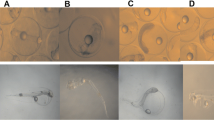Abstract
The toxicity of fenitrothion was determined in larvae (nauplii, Zoeae 1 to 3, Mysis 1 to 3), postlarvae (PL stages) and juvenile shrimp (Penaeus japonicus Bate), in two media, seawater (SW) and diluted seawater (DSW) (1100 and 550 mosM kg−1, ≃ 37 and 19‰ S). The effects of fenitrothion on the osmoregulatory capacities (OC) of juveniles were recorded. A gill and epipodite histopathological study was also conducted. For larvae in seawater, 24 and 48 h LC50s ranged from 32.9 μg l−1 (Zoeae 2) to 10.7 μg l−1 (Mysis 3), and from 3.9 μg l−1 (Zoeae 3) to 2.0 μg l−1 (Mysis 3), respectively; 48 and 96 h LC50s in postlarvae (PL) at the same salinity ranged from 1.8 μg l−1 (PL1) to 0.6 μg l−1 (PL5), and from 0.3 μg l−1 (PL7) to 0.4 μg l−1 (PL15). In juveniles, 96 h LC50s were 0.8 μg l−1 in seawater and 1.5 μg l−1 in diluted seawater. From hatching to juvenile stages, the overall trend was a rapid decrease (from nauplii to PL5–PL7) followed by a slight increase (from PL7 to PL15 and juveniles) in the shrimp's ability to tolerate the insecticide. In juveniles kept in seawater and in diluted seawater, fenitrothion decreased the osmoregulatory capacity (OC = difference between the hemolymph osmotic pressure and the osmotic pressure of the medium) at both lethal and sublethal concentrations. This effect was time- and dose-dependent. In SW, the decrease in hypo-OC was ˜ 25% at sublethal concentrations and ˜ 35% at the 96 h LC50. In DSW, the decrease in hyper-OC was ˜ 10 to 15% at sublethal concentrations. In SW, shrimp were able to recover their OC in less than 48 h when transferred to water free of pesticide. In DSW, recovery at 48 h was only possible after exposure to the lowest tested sublethal concentration. Haemocytic congestions (thrombosis) of the gills, lamellae necrosis and other alterations of gills and epipodites (breakage of the cuticle, reduction of the hemolymph lacunae) were noted in juveniles exposed to lethal and sublethal concentrations of fenitrothion.
Similar content being viewed by others
Author information
Authors and Affiliations
Additional information
Received: 7 October 1996 / Accepted: 13 November 1996
Rights and permissions
About this article
Cite this article
Lignot, JH., Trilles, JP. & Charmantier, G. Effect of an organophosphorus insecticide, fenitrothion, on survival and osmoregulation of various developmental stages of the shrimp Penaeus japonicus (Crustacea: Decapoda). Marine Biology 128, 307–316 (1997). https://doi.org/10.1007/s002270050096
Issue Date:
DOI: https://doi.org/10.1007/s002270050096




